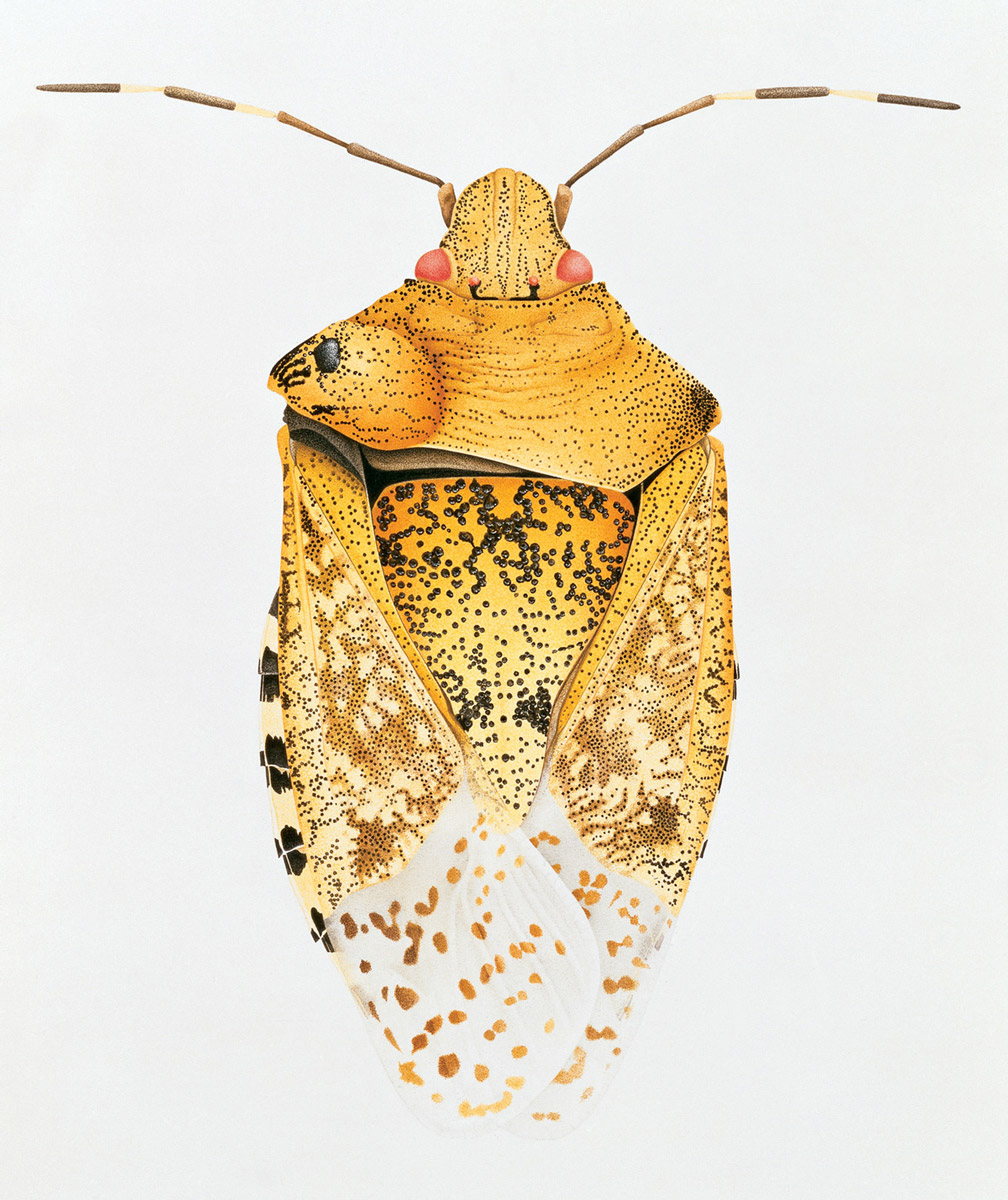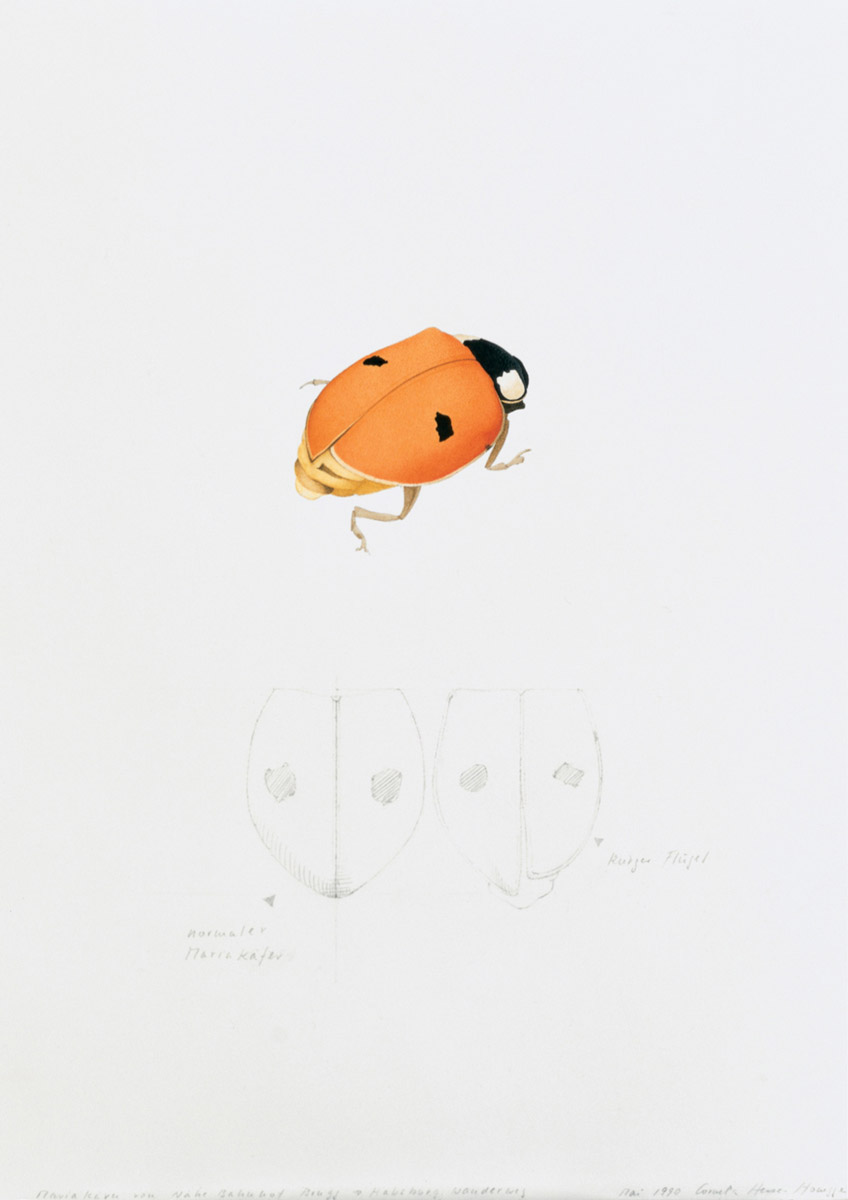Artist Project / Mutations
Unnatural selections
Cornelia Hesse-Honegger

After completing an apprenticeship as a scientific illustrator at the University of Zurich’s Zoological Institute in the early 1960s, I continued to work there for twenty-five years, mostly drawing flies for taxonomic identification. At the age of twenty-four, I was given the assignment to draw mutated fruit flies, which I then started also to paint and sculpt in clay at home. The disturbed faces of these mutated insects were to determine my future.
After moving to the countryside with my family in 1976, I started to paint leaf bugs, spiders, and ladybird beetles on graph paper, a practice that formed the foundation for my later research. In 1985, I decided to go back to painting mutated laboratory flies, considering them to be the prototypes of a new man-made nature. No longer poisoned with chemicals as they had been in the 1960s, these later generations had been irradiated with X-rays.
And then on 26 April 1986, the accident at Chernobyl occurred, irradiating all of Europe. I imagined that insects in contaminated areas would necessarily show some of the same mutations I had seen in the laboratory. Ignoring the scientists who assured me that no visible effects could be expected, in the summer of 1987 I traveled to eastern Sweden, where the radiation had been highest in Western Europe. There, I found my first mutated leaf bugs, which I painted in my hotel room.

After my return, I continued my research and painting in the vicinity of Swiss nuclear power plants that, like all others, emit low-level radiation thought to be too weak to have any effect on living creatures. This turned out to be manifestly false given the very visible mutations that many of the insects around these plants had undergone. I extended my studies to the areas around the nuclear reprocessing plants in Sellafield, UK, and La Hague, France, as well as the nuclear power plants in Krümmel, Stade, and Gundremmingen, Germany. In the US, I traveled to Three Mile Island, to the nuclear test grounds in Nevada and Utah, and to the areas surrounding the atomic bomb factories near Hanford, Washington. I confirmed a staggering array of mutations around all these sites. And in 1990, I finally had the opportunity to travel around the Chernobyl nuclear power plant and collect leaf bugs.

Through this research in the field, as well as through the act of describing these deformities through the pictorial process, I can show that “low-level radiation” emitted from even the best-maintained nuclear plants is in fact extremely dangerous to nature and, thus, also to human beings. In part, what has allowed us to ignore these facts is that we are incapable of seeing the damage. This is, to some degree, a question about the relationship between seeing and knowing. Today, we consider scientific drawings to be mere illustrations, visual representations of what we already know—we think these illustrations show us what has already been seen, thought, and said. But from the Middle Ages until the twentieth century, scientists used illustration as a primary mode of research, as a means of seeing and knowing what cannot be seen or known without the act of connecting eye and hand. I believe in this tradition of using drawing and painting to research nature. My drawings make visible; they are a form of non-verbal communication.
The language of disturbance is the language that we humans have chosen, and it is this language that we leave for our children. Instead of becoming more reasonable about the use of atomic energy, our society now tolerates the worst. My hope is that my work can help open our eyes to what we are doing.
Cornelia Hesse-Honegger is an artist based in Switzerland. She has recently had solo exhibitions at the Scalo Gallery, New York, and Forum Schloss Platz in Aarau, Switzerland. Her work can be found in the book Heteroptera (Scalo, 2002).
Spotted an error? Email us at corrections at cabinetmagazine dot org.
If you’ve enjoyed the free articles that we offer on our site, please consider subscribing to our nonprofit magazine. You get twelve online issues and unlimited access to all our archives.